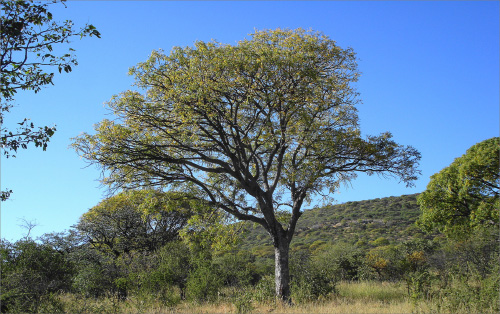LUISE HOFFMANNTHESE graceful single-stemmed trees grow mainly on hill and mountain slopes, koppies and rocky outcrops from the Karstveld through Kaokoland up to the Kunene River, occasionally also on adjacent plains.
They probably are the most common species on the hill slopes along the public roads connection Otavi, Grootfontein and Tsumeb. They are also found on the hills and mountains around Outjo and on the south-eastern slopes of the Waterberg. In summer their large, rounded, light green crowns are clearly visible on the hillsides as are their golden yellow autumn colours from April onwards.
Names: E. [also] Common kirkia, white syringe; G. Bergsyringe; A. Bergsering, Witsering; H. Omuhoho; N/D. !gurue.b; Ky. Omulemba. The scientific name Kirkia honours Dr John Kirk, an explorer and sometime travelling companion of David Livingstone; acuminata refers to the narrow leaves which gradually taper towards a sharp point. The trees reach a height of 6 to 15 m and the bark is pale grey, crumbly and grooved to expose a dark underbark. Thick, exceptionally long roots can often been seen snaking far over the rocky ground around the base of the tree.
Fairly large, coarsely divided leaves with 4 – 6 lateral pairs of leaflets and one terminal leaflet grow in clusters at the tips of the branches. They are rather similar to those of the syringa (Melia azedarach) commonly found in Namibian gardens, however, the leaves of the mountain syringa are a paler green.
Clusters of yellowy flowers appear in response to rain from October to March and develop into angular, woody capsules on upright panicles. Some of the dry fruits usually remain on the tree for a long time, aiding in identification. They split into 4 valves each containing one seed. [The Kaoko syringa (Kirkia dewinteri), a rare and endemic species confined to a very restricted area in Kaokoland, has 20 – 40 pairs of leaflets and the seed capsule splits into 8 valves when ripe].
Uses: Though not very durable, the wood has been used to make lovely furniture. However, it contains silicate crystals which quickly blunt tools. In Kaokoland the inner bark is used to make ropes. In hot weather many animals repair to the cool shade of these large trees.
The fleshy roots of the white syringa store water. For humans to make use of this water, a root about 80 mm in diameter and spreading close to the surface of the soil is dug up for about 1 m. It is first cut off on the end closest to the tree and then on the other end. A strip of bark about 5 cm wide is removed around the thicker end. The root is then held at an angle with the thick end lowest and soon a clear, tasty and thirst quenching liquid drops from the cut end. The roots may also just be chewed in order to enjoy their thirst quenching properties.
The leaves, gum and roots provide a snake-bite antidote, while mugs, milk buckets and butter tubs are carved from the wood.
To see the mountain kirkia go to the new building of the Auditor General corner Robert Mugabe Ave and Bahnhof Str where quite a number of these trees as well as many African wattles (Peltophorum africanum) have been planted.
Stay informed with The Namibian – your source for credible journalism. Get in-depth reporting and opinions for
only N$85 a month. Invest in journalism, invest in democracy –
Subscribe Now!





